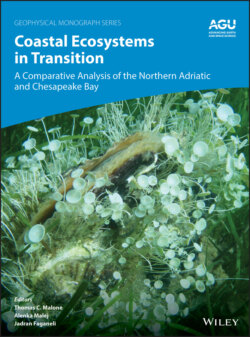Читать книгу Coastal Ecosystems in Transition - Группа авторов - Страница 19
1.2.3.2. Shallow Water Habitats
ОглавлениеLike many sublittoral zones worldwide, both systems have experienced dramatic declines in the spatial extent of tidal marshes and submerged aquatic vegetation (seagrass meadows and indigenous macroalgae) as a consequence of cultural eutrophication, coastal development, and sea‐level rise. In this regard, it is noteworthy that relative sea‐level rise (due to both subsidence and eustatic sea‐level rise) is similar in both systems (1.2–8.5 mm year−1 in the NAS and 3.2–4.7 mm year−1 in CB). Seagrass meadows that once covered ~190 km2 in the north and eastern NAS began to disappear in the 1970s. Today only isolated patches exist in scattered locations in the eastern NAS. Likewise, seagrass meadows, once abundant in CB (~750 km2), have been in decline since 1972 when runoff from a tropical storm transported massive amounts of nutrients into the bay. In 1984, seagrass area was estimated to be ~160 km2. This sustained loss of seagrass habitat during the 1970s and 1980s was primarily due to nutrient enrichment and associated growth of phytoplankton and epiphytic algae that reduced the amount of light available to the grasses. In the NAS, kelp and seagrass meadows along the eastern margin are being lost with some being replaced by turf forming species.
